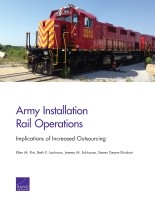| 来源类型 | Research Reports
|
| 规范类型 | 报告
|
| DOI | https://doi.org/10.7249/RR2009
|
| ISBN | 9780833098689
|
| 来源ID | RR-2009-A
|
| Army Installation Rail Operations: Implications of Increased Outsourcing |
| Ellen M. Pint; Beth E. Lachman; Jeremy M. Eckhause; Steven Deane-Shinbrot
|
| 发表日期 | 2017
|
| 出版年 | 2017
|
| 页码 | 68
|
| 语种 | 英语
|
| 结论 |
The Army May Be Able to Obtain Some Modest Cost Savings by Privatizing Rail Operations at Installations with Low Rail Activity Rates That Currently Have Government-Owned, Government-Operated (GOGO) or Government-Owned, Contractor-Operated (GOCO) Business Models- When compared with the fixed costs of paying full-time rail crews and maintaining locomotives, we find that installations that ship an average of fewer than 30–40 rail cars per month are likely to have lower costs under the privatized model.
- However, the annual cost savings are modest, most likely less than $300,000 per year at each installation.
The Potential Cost Savings from Privatization Must Be Weighed Against Possible Risks- The Army will be dependent on commercial rail carriers to provide locomotives and rail crews in a timely manner to load equipment and containers.
- The Army may lose some internal surge capacity, because GOGO and GOCO installations share rail crews when they need to conduct 24-hour operations to load a brigade combat team's equipment for a deployment or training rotation.
- There may be an increased risk of accidents or violations of safety and environmental rules if commercial rail crews are unfamiliar with the installation's rail infrastructure.
- There may be unexpected additional costs, because commercial rail carriers currently bid separately for each shipment and some have local monopoly power to raise rates.
|
| 摘要 |
- When making privatization decisions at specific installations, the Army should consider factors such as the installation's deployment requirements, whether it shares its rail crews with other installations, whether it is served by a local monopoly rail carrier, and the cost of any infrastructure investments that would be needed to support privatization.
- Some of the risks of privatization can potentially be mitigated by specifying contract terms and conditions with rail carriers before privatizing installation rail operations.
- These contracts should specify the cost and availability of rail crews and locomotives for peacetime and surge operations, including contingency plans for short-notice deployments.
- They should also specify any requirements for rail crews, such as familiarity with the installation rail infrastructure, Department of Defense background checks, and adherence to safety, security, and environmental rules.
|
| 主题 | Military Facilities
; Military Logistics
; Railway Transportation
; United States Army
|
| URL | https://www.rand.org/pubs/research_reports/RR2009.html
|
| 来源智库 | RAND Corporation (United States)
|
| 引用统计 |
|
| 资源类型 | 智库出版物
|
| 条目标识符 | http://119.78.100.153/handle/2XGU8XDN/108625
|
推荐引用方式
GB/T 7714 |
Ellen M. Pint,Beth E. Lachman,Jeremy M. Eckhause,et al. Army Installation Rail Operations: Implications of Increased Outsourcing. 2017.
|
|
文件名:
|
x1515417920687.jpg
|
|
格式:
|
JPEG
|

|
文件名:
|
RAND_RR2009.pdf
|
|
格式:
|
Adobe PDF
|
除非特别说明,本系统中所有内容都受版权保护,并保留所有权利。